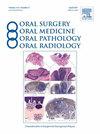由于骨转移的发展,乳腺癌患者从低剂量骨修饰剂切换到高剂量后MRONJ的发病:一项单中心回顾性队列研究
Oral surgery, oral medicine, oral pathology, oral radiology, and endodontics
Pub Date : 2022-10-13
DOI:10.3390/oral2040026
引用次数: 0
摘要
背景:颌骨药物相关性骨坏死(MRONJ)是一种主要与骨修饰剂(bma)相关的药物不良反应。乳腺癌(BC)是世界上最常见的癌症。它的治疗可以导致癌症治疗性骨质流失(CTIBL),通常用BMAs治疗。本回顾性研究的目的是:描述因CTIBL接受BMAs治疗的BC患者的特征;记录任何转向高剂量bma的情况;评估MRONJ的发病并确定与之相关的任何因素。患者:作者包括转介到口腔医学(巴勒莫大学医院)预防MRONJ的患者。结果:14例接受低剂量bma治疗的女性BC患者(平均年龄66.6岁)符合条件。4名患者改用高剂量bma治疗骨转移。4例患者中有2例出现MRONJ: 1例在下颌骨(利塞膦酸钠治疗48个月,Xgev治疗60个月);另一组在上颌骨(Prolia®治疗20个月,唑来膦酸钠治疗16个月)。结论:从理论上可以推断,接受CTIBL的BMAs治疗的BC患者可能与骨代谢患者有相似的MRONJ风险。这些患者需要更仔细地监测口腔健康,因为为了预防或治疗骨转移,他们可能会改用更重的BMAs治疗,从而增加MRONJ的风险。本文章由计算机程序翻译,如有差异,请以英文原文为准。
Onset of MRONJ in Breast Cancer Patients after Switching from Low to High Dose of Bone Modifying Agents Due to Bone Metastases Development: A Single Center Retrospective Cohort Study
Background: Medication-Related Osteonecrosis of the Jaw (MRONJ) is an adverse drug reaction mainly associated to bone modifying agents (BMAs). Breast cancer (BC) is the most frequent cancer worldwide. Its therapy can cause cancer treatment-induced bone loss (CTIBL), commonly treated with BMAs. The aims of this retrospective study are: to describe characteristics of BC patients under BMAs for CTIBL; to record any switch to high-dose BMAs; to assess MRONJ onset and to identify any factors associated with it. Patients: Authors included patients referred for MRONJ prevention to the Unit of Oral Medicine (University Hospital of Palermo). Results: Fourteen female BC patients under low-dose BMAs for CTIBL were eligible (mean age 66.6 years). Four patients switched to high-dose BMAs for bone metastases. In two of the four, MRONJ developed: one case, in the mandible (risedronate for 48 months then Xgev® for 60 months); the other case, in the maxilla (Prolia® for 20 months then zoledronate for 16 months). Conclusion: It can be theorized that BC patients under BMAs for CTIBL are likely to have MRONJ risk similar to osteo-metabolic patients. These patients need more careful monitoring of oral health since they may switch, for preventing or treating bone metastases, to heavier BMAs therapy, thus increasing their risk of MRONJ.
求助全文
通过发布文献求助,成功后即可免费获取论文全文。
去求助
来源期刊
自引率
0.00%
发文量
0
审稿时长
1 months

 求助内容:
求助内容: 应助结果提醒方式:
应助结果提醒方式:


